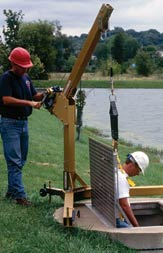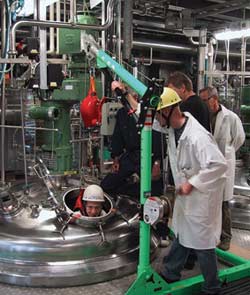
Getting Ready for Rescue
A rescue system must be lightweight and easy to transport, assemble, and store. In an emergency situation, every second counts.
- By Craig Firl
- Aug 14, 2007
 THE American Federation of State, County and Municipal Employees (AFSCME) defines a confined space as an area that has limited openings for entry and exit, has poor natural ventilation that can pose serious risks, and is not designed for continuous occupancy by workers. Workers in various industries are required to inspect, clean, test, and maintain these spaces, making it incredibly important that proper safety precautions are in place to prevent injuries from falls.
THE American Federation of State, County and Municipal Employees (AFSCME) defines a confined space as an area that has limited openings for entry and exit, has poor natural ventilation that can pose serious risks, and is not designed for continuous occupancy by workers. Workers in various industries are required to inspect, clean, test, and maintain these spaces, making it incredibly important that proper safety precautions are in place to prevent injuries from falls.
Confined spaces (such as sewers, tanks, or manholes) are one of the most challenging rescue situations. Access can be difficult given small openings and a lack of space. Along with these concerns, confined spaces often present additional risks, such as the lack of oxygen or noxious air that makes immediate rescue a priority. The timely nature of these rescues can lead to poorly planned attempts. Two-thirds of the deaths in confined space rescue situations occur when a person is trying to rescue someone else. Proper equipment to perform quick and safe rescues is essential.
When it comes to confined space rescues, it is imperative that equipment operates perfectly and quickly. Rescue and retrieval are critical pieces of any fall protection program. The efficient and effective performance of these tasks can mean the difference between a non-injury fall and one resulting in serious worker harm. Equipment choices depend on the specific job site and typically include one of the following: tripods, davit arms, winches, self-retracting lanyards, comprehensive rescue systems, and descent devices.
Equipment Selection Criteria
There are six main criteria to consider when selecting confined space rescue equipment: ease of use, mechanical systems, durability, versatility, strength, and portability.
1. Ease of use: During an emergency, speed and safety are the primary concerns. Decisions must be made quickly, and there is no room for error. To allow for the safest rescue, the equipment chosen for the task must be easy to assemble and operate.
2. Mechanical systems: The mechanical device is one of the most critical parts of the rescue system. It provides the means to hoist an incapacitated worker to safety. Lifeline type and length are just a few of the options. In some situations, a secondary or backup system is required. Backup systems are required when the person is supported or suspended from the primary line in non-emergency situations. For example, if a person is lowered partway into a confined space to perform maintenance activities, the suspended person should also be protected by a backup lifeline such as a self-retracting lifeline or rope grab and lifeline system.
3. Durability: Confined space systems must be built to stand up to the harshest environments. Components must be designed from quality materials that are strong enough to endure rough use and exposure to the elements.
4. Versatility: The confined space system should be adjustable, readily adapting to extreme environment and uneven terrain. A modular design is also helpful, allowing additions to the system over time.
5. Strength: The system must be rated for the application it will be used for, such as fall arrest, rescue, man-riding, or material handling. Choose a system that has been designed to maximize strength and minimize weight.
6. Portability: The portability of a rescue system is an important factor. It must be lightweight and easy to transport, assemble, and store. In an emergency situation, every second counts.
Accessories (such as a boatswain's chair or Y-lanyard) can be useful tools for confined space rescue. Because comfort and the proper support are critical, workers and employers must select equipment that will allow them to be suspended for long periods of time with reasonable comfort.
Important Elements of the ANSI Z359.4 Standard
The American National Standards Committee on Standards for Fall Protection has now approved a new standard for rescue systems. The changes include the addition of a standard that specifically addresses safety requirements for rescue systems typically used in confined space rescue. As stated in the draft, the standard covers: "requirements for the performance, design, marking, qualification, instruction, training, use, maintenance and removal from service of connectors, winches/hoists, descent control devices, rope tackle blocks and self-retracting lanyards with integral rescue capability comprising rescue systems, utilized in pre-planned self-rescue and assisted-rescue applications for 1-2 persons" (Safety Requirements for Assisted-Rescue and Self-Rescue Systems, Subsystems and Components (Draft), American National Standard, American Society of Safety Engineers, revised December 2006).
Individuals engaged in confined space rescue operations will benefit from and be required to comply with the information contained in this standard. The standard discusses the equipment and performance criteria for systems and components used in assisted- and self-rescue situations. The standard also addresses training and pre-planning requirements and establishes criteria for equipment marking, testing, care, and use.
The new standard lays out general system requirements, definitions about the operation and function of self-retracting lanyard components with integral rescue capabilities (RSRL), and requirements for synthetic rope tackle blocks and descent devices. The standard also details methods for equipment testing and training; requirements for inspection, maintenance, and storage, including the provision that the equipment be inspected prior to each use and on an annual basis by a competent person; and requirements for marking and instructions.
Similar to ANSI Z359.1, this Z359.4 standard requires the rescuer to assess workplace conditions where rescue equipment may be required prior to selecting a rescue system. Equipment selection must be based on compatibility with other fall protection equipment, as well as hazards and anchorages that are present in the environment.
End users of confined space rescue equipment will need to become familiar with the changes proposed in ANSI Z359.4 to ensure their job sites are safe and compliant.
Specific actions will need to be undertaken, including the following:
• End users will be required to check current inventories of equipment to ensure it is compliant with the proposed standard.
• Processes will need to be put in place that are compliant with the standard, including naming a competent person to inspect equipment.
• Fall hazard assessments will need to be performed at workplaces to determine what equipment will be needed to rescue someone after a fall.
• Rescue plans will need to be in place before a rescue situation arises.
• Work sites should not depend on emergency services for every rescue situation. If emergency services are not able to answer a request for assistance in a timely manner or if they do not have adequate equipment, then companies should have in-house rescue procedures and trained personnel in place.
• Users of fall protection equipment will be trained on how to use rescue equipment in addition to fall arrest equipment and should practice using the equipment.
Rescue Plan: An Essential Part of Fall Protection
Today's technology dictated the need for this addition to the original Z359.1 standard. As the standard demonstrates, an essential part of any fall protection plan is a rescue plan. The addition of this standard ensures that equipment used to rescue workers after a confined space fall is just as protective as the fall arrest equipment itself.
This article originally appeared in the August 2007 issue of Occupational Health & Safety.